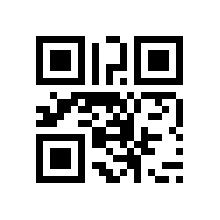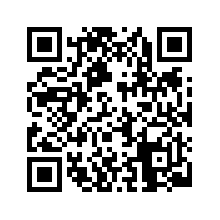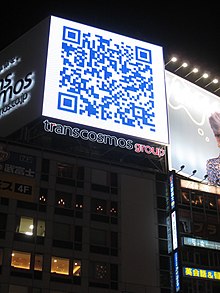QR code
 QR code for the URL of the English Wikipedia Mobile main page. Note that the white border is part of the encoding |
A QR code (abbreviation for Quick Response code) is a specific matrix barcode (or two-dimensional code) that is readable by dedicated QR barcode readers and camera telephones. The code consists of black modules arranged in a square pattern on a white background. The information encoded may be text, URL, or other data.
Common in Japan, where it was created by Toyota subsidiary Denso-Wave in 1994, the QR code is one of the most popular types of two-dimensional barcodes. The QR code was created to allow its contents to be decoded at high speed.[1]
The technology has seen frequent use in Japan and South Korea, while the West has been slower in the adoption of QR codes.[2]
Contents[hide] |
[edit] Overview
Although initially used for tracking parts in vehicle manufacturing, QR codes now are used in a much broader context, including both commercial tracking applications and convenience-oriented applications aimed at mobile phone users (termed mobile tagging). QR codes may be used to display text to the user, to add a vCard contact to the user's device, to open a Uniform Resource Identifier (URI), or to compose an e-mail or text message. Users can generate and print their own QR codes for others to scan and use by visiting one of several free QR code generating sites.
QR codes storing addresses and Uniform Resource Locators (URLs) may appear in magazines, on signs, buses, business cards, or almost any object about which users might need information. Users with a camera phone equipped with the correct reader application can scan the image of the QR code to display text, contact information, connect to a wireless network, or open a web page in the telephone's browser. This act of linking from physical world objects is termed hardlinking or object hyperlinking.
Google's mobile Android operating system supports QR codes by natively including the barcode scanner (ZXing) on some models, and the browser supports URI redirection, which allows QR codes to send metadata to existing applications on the device. Nokia's Symbian operating system is provided with a barcode scanner, which is able to read QR codes,[3] while mbarcode[4] is a QR code reader for the Maemo operating system. In the Apple iOS, a QR code reader is not natively included, but more than fifty free apps are available with reader and metadata browser URI redirection ability. With BlackBerry devices, the App World application can natively scan QR codes and load any recognized Web URLs on the device's Web browser.
Standards
There are several standards in documents covering the physical encoding of QR codes:[5]
- October 1997 — AIM (Association for Automatic Identification and Mobility) International[6]
- January 1999 — JIS X 0510
- June 2000 — ISO/IEC 18004:2000 Information technology — Automatic identification and data capture techniques — Bar code symbology — QR code (now withdrawn)
Defines QR code models 1 and 2 symbols. - September 1, 2006 — ISO/IEC 18004:2006 Information technology — Automatic identification and data capture techniques — QR code 2005 bar code symbology specification
Defines QR code 2005 symbols, an extension of QR code model 2. Does not specify how to read QR code model 1 symbols, or require this for compliance.
At the application layer, there is some variation between implementations. NTT DoCoMo has established de facto standards for the encoding of URLs, contact information, and several other data types.[7] The open-source "ZXing" project maintains a list of QR code data types.[8]
License
The use of QR codes is free of any license. The QR code is clearly defined and published as an ISO standard. Denso Wave owns the patent rights on QR codes, but has chosen not to exercise them.[5]
The term QR code itself is a registered trademark of Denso Wave Incorporated.[9]
Storage
| QR code data capacity[1][10] | |
|---|---|
| Numeric code only | Max. 7,089 characters |
| Alphanumeric | Max. 4,296 characters |
| Binary (8 bits) | Max. 2,953 bytes |
| Kanji/Kana | Max. 1,817 characters |
| Error correction capacity | |
|---|---|
| Level L | 7% of codewords can be restored. |
| Level M | 15% of codewords can be restored. |
| Level Q | 25% of codewords can be restored. |
| Level H | 30% of codewords can be restored. |
QR codes use the Reed–Solomon error correction.
Variants
Micro QR code is a smaller version of the QR code standard for applications with less ability to handle large scans. There are different forms of Micro QR codes as well. The highest of these can hold 35 numeric characters.
Standard QR code is the QR code standard for applications that possess the ability to handle large scans. A standard QR code can contain up to 7089 characters, though not all QR readers can accept that much data.
Uses
Use as artwork
| This section needs references that appear in reliable third-party publications. Primary sources or sources affiliated with the subject are generally not sufficient for a Wikipedia article. Please add more appropriate citations from reliable sources. (April 2011) |
Since 2006, the Italian artist Fabrice de Nola has used QR codes in oil paintings[11] or embedded in photographs.[12]
In 2007 the British pop group Pet Shop Boys used a QR code as the artwork of their download-only single Integral. The videoclip for the song also features a QR code. When the codes are scanned, users are directed to the Pet Shop Boys website, and web pages about the British national identity card plans, respectively.
In 2008, the Australian born artist, Simone O'Callaghan, created a series of screen-printed artworks, called RGB, based on QR codes. Here, she challenged the latitudes of scanning technologies by altering the codes to take on more organic and less pixelated forms, whilst still ensuring that they could be scanned by a mobile phone.[13] They link to quotes about media. She also exhibited another series of works called home.html featuring QR codes linking the photographic prints to online content about the places in which the images were taken. They were exhibited as part of an exhibition called Signals in the City at the Hannah McLure, Abertay University, Dundee, Scotland.[14][15]
In March 2008 software engineer, Duncan Robertson, embedded the BBC logo in a QR code.[16]
In 2010 musician and artist, DJ Spooky, used a QR code in a fine art print exhibited at Experimenta Biennale, Melbourne. Scanning the code takes users to an experiential web-based artwork called the Nauru Elegies,[17] about the complexities of the South Pacific island of Nauru.
A QR code which scans to produce the word "LOVE" was featured prominently in Australian artist Kylie Minogue's music video for her 2010 single, All The Lovers.
In June 2010, Design Exchange, Canada's National Design Centre, unveiled a large QR code installation created by Rollout Wallpaper, a custom wallpaper company operating in Vancouver. The installation is part of the 'Bent Out of Shape' exhibit, curated by Design Exchange staff.
In July 2010, SYCO Music recording artist Labrinth started using QR codes as part of a campaign to promote his debut single "Let The Sun Shine". As well as a cartoon video to educate users on how to use QR codes,[18] they were placed in different media ranging from street posters and stickers to music videos, websites, and social networks. The QR codes take users through to Labrinth's YouTube videos, website, and social network profile.
The webcomic QR Comic is made entirely out of QR codes. The first 28 entries are Isaac Asimov's short story The Last Question converted into QR codes.
The 2010 comic, Carnivale De Robotique used a QR code to reveal a subplot in its third issue.[19]
In October 2010, at the Toronto International Art Fair, artist Jeff Tallon displayed Canada's first QR code painting in collaboration with the Engine Gallery. The work was a diptych that, when scanned, provided information about the adjoining panel.[20]
In April 2011, urban designer, planner and artist Ela Dokonal exhibited mixed media paintings at the Northport ArtWalk[21] that presented a short story about a village and its struggle to revive the local economy.[22] Each painting had a QR code embedded into the painting.[23] To underscore the business and art coalition, the mobile pages included offers from local businesses encouraging users to “buy local”, echoing a message promoted by the local business community. [24][25]
[edit] QRQ
QR code has also been used to create QRQ (Also known as QRku). These are haiku embedded within QR code[citation needed].
[edit] Use as literature
Incorporating the QR code into a new genre called devise literature, authors and publishers are using the graphics to create a bridge between printed and electronic media.
On 31 March 2011, Dutch poet Chielie published a collection of 12 poems, 'QRCode' (ISBN 978-90-8878-011-0), that fits 1 sheet of A4 paper.[26]
On 4 April 2011, United States author and experimental poet Trisha Barnes published a 26 page book titled, 'After The Revolution Has Passed Us By: An Experiment in Technological expression' (ISBN 978-0-9815914-6-9). In the book, all traditional elements and words have been transformed into QR Code. The only traditional words published in the book are on the cover and consist of title and author information.[27]
[edit] Use by government
The Canadian Government embeds a QR code on the front page of their online PDF application form for passports. As the form is filled out, the code is updated. This presumably permits faster automatic scanning when the printed application form is processed.[28]
[edit] Use in marketing
Recently, QR codes have become more prevalent in marketing circles and have been integrated into both traditional and interactive campaigns. Media where QR codes have been deployed include: billboard ads, guerrilla marketing campaigns,[29] in-store displays, event ticketing and tracking, trade-show management, business cards, print ads, contests, direct mail campaigns, websites, email marketing, and couponing just to name a few. QR codes are of particular interest to marketers, giving them the "ability to measure response rates with a high degree of precision"[30] allowing for easier ROI (return on investment) calculation, thus helping to justify spending on marketing budgets. QR codes also have been used at trade shows and in conferences.
In July 2009, QR codes were created for character design and promotional materials in the Shane Acker film 9. The use of QR codes was part of the characters in the movie and culminated into a promotional campaign with unique QR code cards, posters, and street advertisements on billboards or public transportation for major popular art events. These advertisements were largely focused upon the attendees of the 2009 San Diego Comic Con and 2009 Academy Awards. QR codes were integrated into the artwork and symbolized individual characters in the movie. Instructional pamphlets and videos were released to explain how the codes could be retrieved and deciphered. QR-coded artwork could be read with QR-capable cellphones for prizes and access to exclusive online content. This was one of the first major integrations of QR codes with Hollywood studios and urban environments.[31]
In January 2011, U.S. Army Garrison Yongsan in Seoul, South Korea became the first Army organization to use QR codes for official media campaigns.[32]
Also in January 2011, the Memphis Rock 'n' Soul Museum launched a line of museum t-shirts and apparel that feature museum logos and designs on the fronts, and a QR code screened on the right back shoulder, which directs to the museum's web site or artist interviews.
In March 2011 a tattoo parlor in Arizona reportedly began giving QR tag tattoos that linked to people's websites and Facebook pages.[33]
QR codes are widely used in the tourism industry. For example in Lviv (Ukraine), Lviv Tourism Movement that consolidates businessmen have placed QR codes on more than 80 tourism objects. QR codes are written in several languages, which helps individual tourist easily to get the information on the city.[34]
For years marketers have seen the success of QR codes internationally, but in 2011 QR codes might finally be taking hold in the U.S. as prominent endorsements from Target, Best Buy, Macy's, and Post Cereals are exposing the codes to a broad swath of consumers.[35]
In April 2011, Valve Corporation used a QR code as part of their Portal 2 ARG campaign. one of the games participating in the campaign, Defense Grid: The Awakening, had a level in the shape of a QR code that yielded a password for use elsewhere in the ARG. Further, parts of another QR code were shown in a collection of game screenshots. When assembled, the QR code was revealed to be a URL of a countdown at Valve's Aperture Science website.
[edit] Use in entertainment
QR codes are becoming increasingly innovative and more and more ideas for their use are becoming a reality. LBP.me has created a QR code for every user-generated level in LittleBigPlanet 2 for the PlayStation 3, and users only have to do is print that QR code out and hold it in front of the PlayStation 3's dedicated camera, the PlayStation Eye, while the game is running and the game will automatically take the player to that level on the community page. The Nintendo 3DS Mii Maker application can generate a QR code for every possible Mii with the word "Mii" written in the middle of the code, with the Mii's name at the bottom (though the written name is not necessary for scanning). With this code, a Mii can be published and shared on the Internet or in printed material.
A QR code was used to promote Lupe Fiasco's album, "Lasers." The album was launched in the center of San Francisco with a massive QR code which allowed fans to scan it with the Redlaser technology in order to order the album early.
The hip hop collective OFWGKTA used a QR code when they played on Late Night with Jimmy Fallon instead of an album artwork which Jimmy Fallon usually presents. The code redirected to a site on the groups homepage.
[edit] Use in interpretation
QR codes have been used to interpret natural and historical points of interest on nature trails and walking tours, adding to or replacing expensive signs.[36][37]
[edit] Use in books
Ubimark, an Indiana company created with support from the Purdue University Discovery Park, has published a number of books that include QR codes. one of them, a new version of Around the World in 80 Days,[38] uses QR codes to provide readers with quick access to the audio versions of the book chapters and to Google Maps.[39] Another example is the collection of poems "handyhaiku" which was written by Oliver Bendel. The haikus are not only printed in text form, but as QR codes. Users scan their favorite poems onto their cell phone and can send them on to friends and family.[40]
In 2008, the book PHP Reference: Beginner to Intermediate PHP5 was published, using a QR code representing the full title as a cover image for the book. The code cannot be read properly, however, due to overlaid text that exceeds error correction capacity.
[edit] Use in libraries
U.S. and U.K. libraries have begun adopting QR codes as a method of delivering information to patrons via their mobile devices. A number of libraries are using QR codes to direct users to a mobile library website or to a chat or SMS-based reference service.[41] Some have included QR codes within the library catalog (OPAC): scanning the QR code sends information about a resource to the patron's telephone. Often this information includes the title, call number, and availability of the item, so that patrons may save the information to look for the book later, rather than having to write it down.[42] Typically, QR codes are used in libraries as a quick and easy way for patrons to access the library's existing mobile services.
[edit] Use on coins
The Royal Dutch Mint created gold and silver commemorative coins, which incorporate a QR code within the reverse design. When the code is scanned, further information is provided about the coins, which celebrate the 100th anniversary of the construction of the Mint building in Utrecht.[43]
[edit] Use in cemeteries
QR codes have been used in Japanese cemeteries on grave markers as a way to share additional information and unite mourners.[44][45] In the U.S., QR codes are being etched into medallions for distribution in cemeteries by a company called Memory Medallion. The QR code provides the reader access to additional online information (such as images and video) about the deceased.[46]
[edit] Standalone applications
While the adoption of QR codes in some markets has been slow to begin (particularly in markets such as the United States where competing standards such as Data Matrix exist), the technology is gaining some traction in the smartphone market. Many Android, Nokia, and Blackberry telephones come with QR code readers installed. QR reader software is available for most mobile platforms.
[edit] See also
'연구하는 인생 > ♣COMPUTER' 카테고리의 다른 글
| daum cloud 사용에 관하여 (0) | 2011.07.15 |
|---|---|
| Java 기술에 대한 자세한 내용 (0) | 2011.06.24 |
| countif (0) | 2011.04.30 |
| MS Office, Internet Explorer __ 特殊文字 사용 (0) | 2011.04.12 |
| CHKDSK/F D: (0) | 2011.03.30 |










